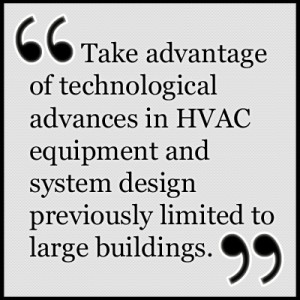
Perhaps most importantly, these technological advances make control and system-integration capabilities affordable for small and mid-sized buildings. They provide functionality similar to large building automation systems (BAS). By taking advantage of the available technologies, buildings of all shapes and sizes can achieve greater energy efficiency and reduce CO2 emissions.
Energy Efficiency Improvements
System Control vs. Thermostat Control
Because they offer the lowest first-cost solution, most small- to mid-sized commercial buildings utilize packaged rooftop units and/or heat pumps that are controlled using thermostats. Since thermostats are decentralized, it can be time-consuming to schedule changes and perform building checks. System controls, on the other hand, monitor the status of a building’s HVAC components, providing alerts when issues arise. With all system components working together, system control offers business owners and property managers more control, greater insights, and thus the potential for greater savings.
According to a 2004 study conducted by the New Building Institute, 91% of packaged rooftop units had at least one problem that increased cooling energy consumption by up to 40%. With system control, these problems could be detected.
Packaged HVAC Systems
Small packaged HVAC systems with integrated controls offer small and mid-sized buildings most of the control functionality of larger BAS, but in a much more affordable package. These packaged solutions do not require on-site engineering or custom programming. All of the components can be programmed at the factory, enabling quick set up. And intuitive web-browser based user interfaces make these systems easy to use.
Packaged HVAC systems can affordably increase efficiency and comfort.
Additional Energy Efficiency Improvements:
- Variable Air Volume (VAV): VAV systems use an estimated 60% less airflow than constant-volume bypass systems, which are typically found in small to mid-sized buildings. However, bypass systems are not designed for efficiency. Variable-frequency drives (VFDs) now eliminate the bypass system and increase efficiency, plus have reduced in cost.
- HVAC Scheduling: Centralized HVAC scheduling can reduce run time, eliminate waste, and improve energy efficiency.
- Supply-Temperature Reset: These allow rooftop units to reduce cooling energy use based on various factors, including outside-air temperature, return-air temperature, or worst case zone.
- Pressure Reset: By adjusting duct-pressure setpoints on VAV based on the worst-case zone, building owners can experience energy savings of 30-50% over typical fixed-pressure setpoints.
- DCV: Demand Controlled Ventilation can tailor the amount of fresh air introduced into a building to improve indoor air quality (IAQ) and lower energy use
- Demand Response: A system-level HVAC approach enables implementation of demand-response requests from power companies. Thermostats are not equipped to provide this level of control.
- Alarm/Fault Management: These systems give building owners and property managers an early indication of improper operation, allowing for proactive response.
In summary, packaged HVAC systems are pre-engineered and can be preconfigured at the factory, making implementation easy with near plug-and-play startup. Best of all, these efficient systems are affordable, resulting in high-performance buildings that save energy and costs.
HVAC and Mechanical Contractor in Metropolitan Washington, DC Area
To learn more about Packaged HVAC Systems, please contact Crockett Facilities Services (CFSI) at 202.600.2787 or sales@crockett-facilities.com. As a commercial HVAC and mechanical contractor, CFSI helps building owners, property managers and facility engineers to lower their operating expenses and energy costs through preventive HVAC maintenance in Maryland, Virginia and Washington, DC.
Like us on Facebook; follow us on LinkedIn, Twitter, and Google+.
Sources:
Improving the Efficiency of Small to Mid-Sized Buildings, HPAC.com
